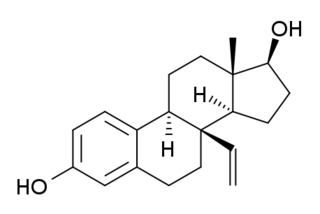Müller's muscle can refer to:
- Superior tarsal muscle
- Orbitalis muscle
- Circular fibres of the ciliary muscle
Müller's muscle can refer to:

Bodybuilding is the use of progressive resistance exercise to build, control, and develop one's muscles via hypertrophy. An individual who engages in this activity is referred to as a bodybuilder. It is primarily undertaken for aesthetic purposes over functional ones, distinguishing it from similar activities such as powerlifting, which focuses solely on gaining physical strength.

Skeletal muscles are organs of the vertebrate muscular system and typically are attached by tendons to bones of a skeleton. The muscle cells of skeletal muscles are much longer than in the other types of muscle tissue, and are often known as muscle fibers. The muscle tissue of a skeletal muscle is striated – having a striped appearance due to the arrangement of the sarcomeres.

Megan Mullally is an American actress, singer and comedian. She is best known for playing Karen Walker on the NBC sitcom Will & Grace, for which she received eight Primetime Emmy Award nominations for Outstanding Supporting Actress in a Comedy Series, winning twice, in 2000 and 2006. She also received nominations for numerous other accolades for her portrayal, including seven consecutive Screen Actors Guild Awards nominations for Outstanding Performance by a Female Actor in a Comedy Series, winning three times, in 2001, 2002, and 2003, as well as receiving four Golden Globe Award nominations.

Becker muscular dystrophy is an X-linked recessive inherited disorder characterized by slowly progressing muscle weakness of the legs and pelvis. It is a type of dystrophinopathy. This is caused by mutations in the dystrophin gene, which encodes the protein dystrophin. Becker muscular dystrophy is related to Duchenne muscular dystrophy in that both result from a mutation in the dystrophin gene, but has a milder course.
Twitch may refer to:

An isometric exercise is a form of exercise involving the static contraction of a muscle without any visible movement in the angle of the joint. The term "isometric" combines the Greek words isos (equal) and -metria (measuring), meaning that in these exercises the length of the muscle and the angle of the joint do not change, though contraction strength may be varied. This is in contrast to isotonic contractions, in which the contraction strength does not change, though the muscle length and joint angle do.

The rib eye or ribeye is a boneless rib steak from the rib section.

In human anatomy, the masseter is one of the muscles of mastication. Found only in mammals, it is particularly powerful in herbivores to facilitate chewing of plant matter. The most obvious muscle of mastication is the masseter muscle, since it is the most superficial and one of the strongest.
Myosarcoma is a malignant muscle tumor. People with myosarcoma often wake up with the feeling as if they had a cramp during their sleep.

The internal intercostal muscles are a group of skeletal muscles located between the ribs. They are eleven in number on either side. They commence anteriorly at the sternum, in the intercostal spaces between the cartilages of the true ribs, and at the anterior extremities of the cartilages of the false ribs, and extend backward as far as the angles of the ribs, hence they are continued to the vertebral column by thin aponeuroses, the posterior intercostal membranes. They pull the sternum and ribs upward and inward.

The superior tarsal muscle is a smooth muscle adjoining the levator palpebrae superioris muscle that helps to raise the upper eyelid.
The orbitalis muscle is a vestigial or rudimentary nonstriated muscle that crosses from the infraorbital groove and sphenomaxillary fissure and is intimately united with the periosteum of the orbit. It was described by Heinrich Müller and is often called Müller's muscle. It lies at the back of the orbit and spans the infraorbital fissure. It is a thin layer of smooth muscle that bridges the inferior orbital fissure. It is supplied by sympathetic nerves, and its function is unknown.

Ptosis, also known as blepharoptosis, is a drooping or falling of the upper eyelid. This condition is sometimes called "lazy eye," but that term normally refers to the condition amblyopia. If severe enough and left untreated, the drooping eyelid can cause other conditions, such as amblyopia or astigmatism, so it is especially important to treat the disorder in children before it can interfere with vision development.
Heinrich Müller was a German anatomist and professor at the University of Würzburg. He is best known for his work in comparative anatomy and his studies involving the eye.

Four and a half LIM domains protein 1 is a protein that in humans is encoded by the FHL1 gene.

Four and a half LIM domains protein 3 is a protein that in humans is encoded by the FHL3 gene.

Central core disease (CCD), also known as central core myopathy, is an autosomal dominantly inherited muscle disorder present from birth that negatively affects the skeletal muscles. It was first described by Shy and Magee in 1956. It is characterized by the appearance of the myofibril under the microscope.
Mullally or Mulally or Mullaly or Mulaly is a surname of Irish origin thought to have originated from County Galway where it has since been shortened to the form of Lally.

8β-VE2, or 8β-vinylestradiol, also known as 8β-vinylestra-1,3,5(10)-triene-3β,17β-diol, is a synthetic estrogen featuring an estradiol core. It is a highly potent and selective agonist of the ERβ that is used in scientific research to study the function of the ERβ. It has 190-fold higher potency in transactivation assays of the ERβ relative to the ERα and 93- (rat) and 180-fold (human) preference in binding affinity for the ERβ over the ERα.